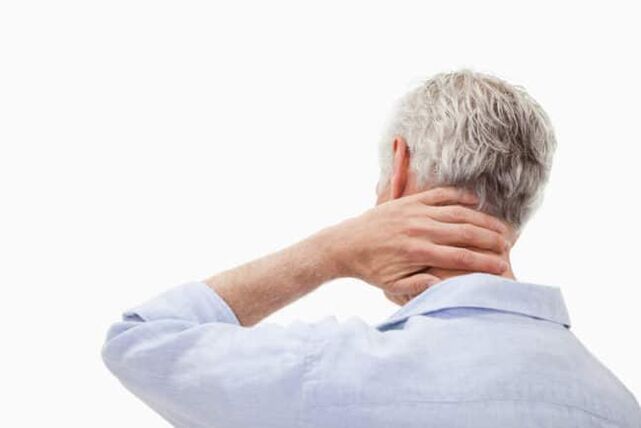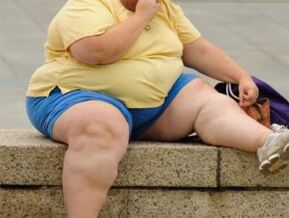Of all the pathological processes that affect the spine in different parts, the cervical osteochondrosis is considered one of the most common and painful.This disease leads to many complications, mainly because it affects the spinal cord and negatively affects the function of the brain.

What is the cervix osteochondrosis?
The words of osteochondrosis of the cervix in medical practice are a acquired progressive disease that affects the specific spine.This abnormal process is characterized by degenerative-dynist processes in the tissues of the intervertebral discs, which are the cervical vertebrae.Degenerative-dynight changes in intervertebral discs are due to the fact that they have been deleted and deformed.As a result, the distance between the vertebrae is reduced and as a result the following consequences occur:
- Narrowing the spinal canal in certain areas of the spine.
- Transfer of spine arteries - large blood vessels that provide blood supply to the brain.This is due to the brain's offerings and blood circulation is disturbed in the cervical spinal cord.
- Intervertebral discs may be deformed and flattened.This leads to pressing the spinal cord and certain sections of the nerves, more often the nerve roots smooth.
All of these problems are not only threatened to violate the blood circulation of the brain, cervical pain, headache, etc.The development of osteochondrosis of the cervix is dangerous, with problems of neurological nature, deterioration of the central nervous system and damage to the brain tissue.According to the international classification of diseases, many separate codes have been distributed to the cervical region osteochondrosis.ICB 10 Disease Code depends on the age of the disease: The disease was diagnosed with:

- M02 - Dystrophy of intervertebral discs during adolescence.
- The M42.12 is a dystrophic process in the neck for adults.
Many factors depend on the age of the patient and the degree of development of the pathological process, such as the consequences, complications, symptoms and of course the principles of treatment.
Reasons
Knowledge of the causes of osteochondrosis of the cervical region can play a crucial role in the diagnosis and in determining the principles of fighting the disease.However, before listing the reasons, it is worth saying that doctors distinguish between two factors that lead to this pathological process:
- Pathological - destruction of intervertebral discs and other vertebrates with close tissues, blood vessels and nerve beams in the pathological process due to harmful external factors.The harder these factors and other pathologies, the faster the disease develops.
- Physiological - changes in the age, primarily related to the development of pathology.We talk about the natural aging of cartilage tissues in the spinal column, salts, etc.
If we list the more specific causes of the cervix osteochondrosis, these are:
- Violation of metabolic processes in the body and at certain stages of obesity.
- Hypodynamia is a phenomenon characterized by limiting mobility.Not only is it about injuries or illnesses, it can include a sedentary lifestyle and sedentary work.
- The pathologies of the cardiovascular system, contributing to blood circulation, pressure changes and other things in the brain.
- Incorrect posture, these are various forms of skoliosis, rheumatism and even flat legs.
- Injection of the cervical spine.In this case, we are talking about jerks, strikes, bruises.Examination of other spine in the development of osteochondrosis of the cervix may affect the development of osteochondrosis of the cervix.
- Depending on human activity, excessive physical effort caused by intense sports or heavy physical difficulties.
- The sedentary lifestyle is also dangerous, with the constant tension of the cervix and the entire spine if you sit incorrectly or sit on uncomfortable furniture.
- Damage to the cervical spine and various related diseases.
- Long -term keeping the head in an uncomfortable or unnatural position.In this case, not only is muscle exhaust, but the spine is curved in the cervix region.
- Doctors consider constant stress and nervous surge as a very common cause.
- One cause is considered to be congenital disorders in the structure of the spine.

What is the danger of health?
As mentioned earlier, the cervical spine contains not only the spinal cord and various nerve branches, but also the spinal arteries of the brain, cerebellum, cerebellum and medullavic brain.With the development of osteochondrosis of the cervix, nearby tissues become inflamed.In addition, the development of pathology threatens to print nerve roots and transfer the blood vessels, the consequences are as follows:
- Osteocondrosis is accompanied by deformation of the spine, which results in a cerebrospinal channel narrowing in certain areas.This can lead to austerity of the spinal cord and nervous branches, which promises serious neurological problems.In severe cases, one feels pain, and there is still the possibility that parts of the body (especially in the hand or on the face) lose control.
- Pressing the neck of the neck, as mentioned above, is a violation of blood circulation in the brain's occlital region.At the same time, the brain ceases to be oxygen and nutrients in the previous amount, oxygen starvation begins.In circulatory disorders, there is a real risk of ischemic stroke and various neurological pathologies.
Syndrome
The main syndromes are as follows:
- Spine.
- Spine artery.
- Koreshka.
- Heart.
It is important to know that each of these symptoms is accompanied by various painful feelings and many unfavorable clinical symptoms.One can feel dizzy, noise appears in his ear and much more.

Vertebrate syndrome
He speaks of the direct relationship between osteochondrosis of the cervical region bone and cartilage.Symptoms in this type of pathology are also associated with the lesion of these tissues:
- Neck movement is partially or completely limited.
- The movement of the head is accompanied by cervical pain.
- X -Ray shows morphological changes in tissues (the body of vertebrae and vertebrae).
It is worth noting that the vertebrate syndrome is always accompanied by these three clinical signs.If at least one of them is missing, the diagnosis will be completely different.
Coordinated syndrome
It occurs when the roots of the spinal cord are damaged.At the same time, nervous conductivity is disorder, one may feel pain, or lose the sensitivity of some parts of the body, or even suffer from paralysis.Depending on which of the 8 radicular pairs is disturbed by conductivity, such symptoms are distinguished:
- 1 pair - numbness or pain in the back of the head;
- 3 pairs - violation of chewing reflex, numbness of the tongue and discomfort behind the ears;
- 4 pairs - pain in the wrist, violation of swallowing reflex;
- 5 pairs - violation of the shoulder belt, accompanied by the problem of hand movement;
- 6 pairs - the patient feels pain and numbness in the forearm and blades;
- 7 pairs - hands and fingers numb (often index and middle);
- 8 pairs - problems similar to the past element, but numbness can be felt in the ring finger and small finger.
Cardiac
Despite the fact that the pathological process continues to localize in the cervix's spine, there are all signs of cardiac catologies in the syndrome.The clinical picture is as follows:
- Fast pulse.
- Pain in the sternum region.
- Shortness of breath, weakness, lethargy, power.
Signs and symptoms of osteochondrosis of the cervix
When searching for a doctor on time, signs of osteochondrosis of the cervix should be clearly understood.In some cases, such knowledge allows you to seek help in the early stages of the disease when it is easier to treat.Generally, the symptoms of osteochondrosis of the cervical spine are as follows:

- The pain of osteochondrosis is always present, only the intensity and frequency are different.Pain is the first clinical sign.Their intensity depends on the stage of the disease progress, stupid or squeezed in nature.Painful feelings are primarily present in the neck of the occlital region, but they can radiate to the temporal region, the shoulder belt and hands.
- In most cases, there are manifestations of the vestibular device.We are talking about frequent dizziness, nausea, coordination of movements, uneven walking, loss in space.
- One of the most common clinical symptoms is the stiffness of the cervical muscles and the stiffness of movements.It is difficult for a person to turn, lower and discard his head, and movements react with pain relief.
- Many patients note the feeling that libambums "run through the scalp" or a typical tingling.
- There is muscle weakness and numbness in the hands.
- There are often psychological manifestations that are expressed by depression, drowsiness, sharp change in mood, temperament or irritability.
- As a result of damaged blood circulation and brain tissue damage, dizziness increases and the noise in the ear is similar to rusting, pulsation and ringing.
- Most patients notice vision impairment and pain in the eyeballs, especially when their eyes are tries to mow largely to the left, right, up or down.
Occasionally, the degree of development of the pathological process with symptoms can be determined.However, this is still not enough to diagnose this, and many diagnostic measures are needed.
Diagnostic methods
Diagnosis of osteocondrosis of the cervix is required to determine the localization and stage of the disease.Such diagnostic methods are required for complete diagnosis:
- X -Ray - the primary method that allows the degree and localization of the deformation of the spinal column.
- You can use computer tomography to more accurately diagnose the abnormal changes in vertebrae and intervertebral discs.
- MRI (magnetic mood imaging) - allows detailed examination of wheels and vertebrae, the presence of hernia, protrusions and other lesions.
- Doplerography - At the same time, the examination is possible to find space for pressing the artery and evaluating the degree of circulatory disorders.
Treatment methods
Treatment of cervical osteochondrosis is always an integrated approach.The basic principles of treatment depend on the mass of factors, for example, the age of the patient, the stage of the disease, the brightness of the clinical picture, etc.As for the integrated approach: osteochondrosis of the cervix is treated using medication, physiotherapy, massage, exercise and other methods, which should be discussed in more detail.
Drug treatment
The treatment of cervical osteochondrosis is based on medication, which includes the use of tablets, drugs and medicines of such groups:
- Anesthetics - analgesics and antispamodes.The previous directly dull nerve centers, thereby stopping the painful feelings.The latter allows you to relieve cervical muscles, suppress the bloodstream and pain.
- NSAIDs -the inflammatory process requires non -steroid anti -inflammatory drugs, most of which also eliminate pain.These drugs are often used in the form of gels, ointments that are rubbed into the affected area.
- Musorelaxantok is another way to remove the muscle cramps in the cervical region.
- Condroprotectors are mandatory at certain stages of chop osteochondrosis as they contribute to the restoration of bone tissue.
- Vitamins B - Norms the metabolic processes of nerve tissues, improving the conductivity of nerve impulses and contributing to the work of the central nervous system.
Keep in mind that treatment should only be carried out under the supervision of a physician who is responsible for the appointment of each medication and for determining the duration of intake and dosage.
Physiotherapy
Treatment of cervical osteochondrosis will often be more effective with some physiotherapy techniques:

- Electrophoresis.
- Laser therapy.
- Ultrasound.
- Massage.
Massage therapy is necessarily performed by an experienced health worker and is treated at least 10 sessions.Massages in the cervical region promote normalization of blood circulation, elasticity, muscle tone, pain, etc.
Manual therapy
Manual therapy is based on the basis for the restoration of motor functions and the mobility between the vertebrae.Initially, manipulations are in a light relaxing massage, and the doctor will capture more and more strength, affecting pressure and neck turns.
The use of Kuznetsov applicators for spinal diseases, including osteochondrosis, is one of the therapeutic methods.The effect of adaptation on the cervical region normalizes metabolism, relieves pain, increases muscle tone, improves blood circulation, increases nerve tissue conductivity, etc.To prevent osteochondrosis, it is useful for swimming and hanging horizontal rods every day for 2-3 minutes.



























































































